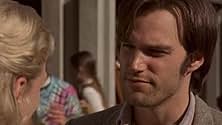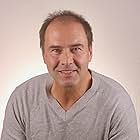Adicionar um enredo no seu idiomaA 60s radical's daughter ventures back in time to undo the bombing which killed him. But the time travel institute who recruited her as a trainee races to stop her before she irreparably dam... Ler tudoA 60s radical's daughter ventures back in time to undo the bombing which killed him. But the time travel institute who recruited her as a trainee races to stop her before she irreparably damages the future. The institute plucked Lorelle out of a fatal car wreck, so she can't retu... Ler tudoA 60s radical's daughter ventures back in time to undo the bombing which killed him. But the time travel institute who recruited her as a trainee races to stop her before she irreparably damages the future. The institute plucked Lorelle out of a fatal car wreck, so she can't return to 1989, but her mother is devastated by her husband's death, so Lorelle hopes to affec... Ler tudo
- Aaron Zgierski
- (cenas de arquivo)
- Leon Zgierski
- (cenas de arquivo)
- Hannah Zgierski
- (cenas de arquivo)
- Gwen Sawyer
- (cenas de arquivo)
Avaliações em destaque
FIRST SCENE AND SECOND SCENE. In the first scene, Kristin is studying outside on a college campus, working on her master's thesis. A stranger tries to make small talk, and they quiz each other about American history from the 1960s. The dialogue is clever and magnificently crafted, as is the dialogue from the entire story. The pair engages in a lively exchange of trivia questions about names of astronauts, names of Academy Award winners, and names of politicians. The first really clever line, is when the stranger asks her, "What was most popular country music country music song on the charts in 1967." Kristin responds, "I don't listen to country music," momentarily showing a brief scowl of disgust. Then, the stranger spills coffee on her notebook, and Kristin reaches over to wipe off the coffee, and the stranger reaches down too, and his ring scrapes on her hand, and a sharp feature of the ring takes a blood sample. The ring acquires the blood sample, and relays the results of DNA analysis to a small computer. The small computer confirms the fact that the woman (Kristin) is the right person for transporting to the future. Kristin's mother is a manager of an apartment building. In the next scene, the mother seems to have a minor illness, but she has been in bed all day, and seems to be emotionally depressed. The mother repeatedly ignores a complaint from one of the tenants who needs a simple repair. Then, Kristin goes off for a drive, swerves to avoid a truck, and plummets off of an embankment to meet certain death. However, a millisecond before striking the ground, Kristin vanishes, and materializes some 50 years in the future, where she finds herself in a time-traveling company. "Where am I," she asks, when she rises from a couch, somewhat dazed. "Not where . . . WHEN," responds an older man, who explains that she is in a facility called, CHRONONICS-TIME TRAVEL FOR HIRE.
SPECIAL EFFECTS. The special effects are excellent, and on par with those in any of the Star Wars movies. The interior of CHRONONICS reminds me, somewhat, of the interior of the floating city in GULLIVER'S TRAVELS, a science fiction movie starring Mary Steenbergen and Ted Danson. The operation of the time machine has plenty of gee-whiz power. Most of the TIME AFTER TIME takes place on the campus of University of California at Berkeley, one day in 1969. Although reconstruction of U.C. Berkeley is not exactly a "special effect," they did a very good job at reconstructing the lingo and period garb from that era. The only major mistake was part of the dialogue referring to a part of the campus called, "The Quad." There never existed any part of the U.C. Berkeley campus called, "The Quad." I should know. I was a student at U.C. Berkeley from the years 1969 to 1980 (undergrad school plus graduate school).
EMOTIONAL IMPACT. There are two kinds of time travel stories. One is where the emphasis is on the whiz-bang nature of time travel and of the associated equipment needed for time travel, such as the stories in the TIME TUNNEL series, and the film, THE TIME MACHINE, starring Guy Pearce. The other kind of time travel movie is that where the emphasis is on a deep-seated nostalgia, and a longing to connect with a time in the past, and to connect with loved ones in the past. TIME TO TIME is the second type of time travel story. Other examples of the second type include Twilight Zone episodes WALKING DISTANCE and A STOP AT WILLOUGHBY, and the full-length film, THE PHILADEPHIA EXPERIMENT. TIME TO TIME is about nostalgia for one's parents (mother and father) in an earlier era, when one's parents were still in their twentys. Regarding the dialogue and acting, I don't see how it is humanly possible to have dialogue that is more clever, razor-sharp, and yet entirely natural. The accompanying facial expressions, those of rubber-faced Kristin Lehman, are a delight throughout the entire story.
Você sabia?
- CuriosidadesThis was a backdoor pilot for a science fiction series which was not picked up. The same was true of Rule of Law (2001).
- Erros de gravaçãoIn 1969, the five-year-old Lorelle asks permission to watch television in her parents' room. When she leaves, Angie explains to the older Lorelle that "it's Smothers Brothers night." However, April 14, 1969 was a Monday and The Smothers Brothers Comedy Hour (1967) aired on Sundays. As such, the relevant episode, Episode #3.25 (1969), aired on April 13, 1969.
- Citações
Nicholas Prentice: One never knows what time will bring.
- ConexõesFeatures The Outer Limits: Tribunal (1999)















